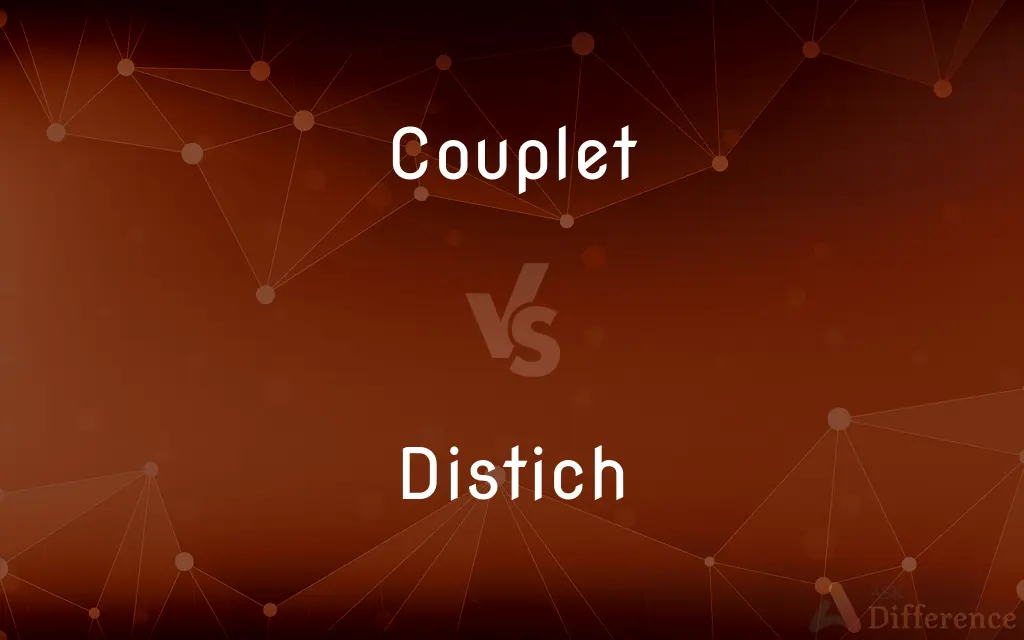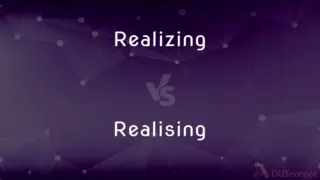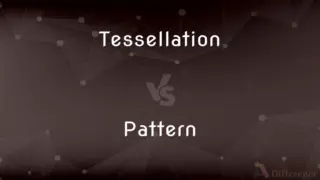Couplet vs. Distich — What's the Difference?
Edited by Tayyaba Rehman — By Fiza Rafique — Updated on April 1, 2024
A couplet consists of two consecutive lines of poetry that usually rhyme and have the same meter, while a distich is a pair of lines that may not follow these conventions.

Difference Between Couplet and Distich
Table of Contents
ADVERTISEMENT
Key Differences
A couplet is a fundamental structural component in poetry, characterized by two lines that often rhyme and share the same meter, making them a popular choice for expressing complete thoughts or statements within a poem. Whereas, a distich can be understood as a more general term for any two lines of verse, regardless of their rhythmic or rhyming connection, thus offering a broader scope in literature beyond the strict confines of rhymed and metered verse.
Couplets are especially prevalent in English poetry, where they serve various functions such as concluding a sonnet with a rhymed pair or forming the entire structure of a poem, as seen in heroic couplets. On the other hand, distichs are not confined to any specific language or tradition and can be found in various forms of poetry across different cultures, highlighting their versatility and universal appeal in literature.
One of the distinguishing features of a couplet is its ability to form a coherent and complete thought or argument within its brief structure, often resulting in a punchy or memorable statement. In contrast, a distich might not necessarily aim to be self-contained or coherent, as its purpose can range from adding structural variety to a poem to serving specific narrative or thematic functions without the emphasis on closure or completeness.
The use of couplets is often deliberate, with poets choosing this form to exploit its rhythmic and rhyming harmony for aesthetic, rhetorical, or thematic effect, thereby enhancing the musicality and memorability of their verses. Meanwhile, the choice of a distich could be motivated by different artistic considerations, such as the desire to juxtapose two lines for contrast, to bridge ideas, or simply to adhere to a poem's overall structural design without the necessity for rhyme or uniform meter.
Despite their differences, both couplets and distichs play crucial roles in the world of poetry and literature. They provide poets with versatile tools for composition, allowing for the exploration of themes, emotions, and narratives in a condensed and impactful form. The choice between using a couplet or a distich often depends on the poet's stylistic preference, the poem's thematic requirements, and the desired emotional or intellectual effect on the reader.
ADVERTISEMENT
Comparison Chart
Definition
Two consecutive rhyming lines with the same meter.
Any pair of verse lines, without requirement for rhyme or meter.
Function in Poetry
Used to conclude thoughts or statements, often with emphasis on rhyme and rhythm.
Used for a variety of structural, thematic, or narrative purposes.
Cultural Prevalence
Common in English poetry and other Western traditions.
Found across various cultures and poetic traditions.
Aim or Purpose
To provide closure, emphasis, or a musical quality to verse.
To offer structural diversity, thematic juxtaposition, or narrative continuity.
Examples of Usage
Heroic couplets in English literature.
Various poetic forms globally, including free verse.
Compare with Definitions
Couplet
Commonly used at the end of sonnets or as a stand-alone poem.
And this, and so much more? It is impossible to say just what I mean!
Distich
Used across various poetic traditions without specific constraints.
Ancient woods, whispering winds.
Couplet
A pair of lines in poetry that rhyme and have the same meter.
True wit is nature to advantage dressed, What oft was thought, but ne'er so well expressed.
Distich
Not limited by language, culture, or poetic form.
Under the spreading chestnut tree, The village smithy stands.
Couplet
A verse form used for expressing a complete thought within two rhyming lines.
The time is out of joint; O cursed spite, That ever I was born to set it right!
Distich
Versatile in usage, from free verse to traditional forms.
Life’s complexity, in two lines captured, Speaks volumes of the journey fractured.
Couplet
A structural element that offers closure or emphasis in poetry.
He is gone on the mountain, He is lost to the forest.
Distich
Can serve to juxtapose ideas, bridge thoughts, or add structural variety.
Silence sings with eloquent tongue, Echoes of hearts once young.
Couplet
A poetic device that enhances the musicality of a poem.
For thy sweet love remembered such wealth brings, That then I scorn to change my state with kings.
Distich
A generic term for any two lines of verse, not necessarily rhyming or having the same meter.
The fog comes on little cat feet. It sits looking over harbor and city.
Couplet
A couplet is a pair of successive lines of metre in poetry. A couplet usually consists of two successive lines that rhyme and have the same metre.
Distich
A pair of verse lines; a couplet.
Couplet
A unit of verse consisting of two successive lines, usually rhyming and having the same meter and often forming a complete thought or syntactic unit.
Distich
A unit of verse consisting of two lines, especially as used in Greek and Latin elegiac poetry.
Couplet
Two similar things; a pair.
Distich
A rhyming couplet.
Couplet
A set of two things, particularly
Distich
(prosody) A couplet, a two-line stanza making complete sense.
Couplet
(literature) A pair of lines, typically with rhyming end words.
Distich
Any couplet.
Couplet
A pair of one-way streets which carry opposing directions of traffic through gridded urban areas.
5th Street is one-way west only and 6th Street is one-way east only. Together, they form a couplet in Downtown Los Angeles.
Distich
Distichous.
Couplet
(taxonomy) A pair of two mutually exclusive choices in a dichotomous key.
Distich
A couple of verses or poetic lines making complete sense; an epigram of two verses.
Couplet
Two taken together; a pair or couple; especially two lines of verse that rhyme with each other.
A sudden couplet rushes on your mind.
Distich
Disposed in two vertical rows; two-ranked.
Couplet
Two items of the same kind
Distich
Two items of the same kind
Couplet
A stanza consisting of two successive lines of verse; usually rhymed
Common Curiosities
Do all couplets rhyme?
While couplets traditionally rhyme, there are exceptions, especially in contemporary poetry that plays with traditional forms.
Are distichs common in modern poetry?
Distichs are used in both traditional and modern poetry, valued for their flexibility and ability to add structural or thematic variety.
What distinguishes a distich from a couplet?
A distich refers to any two lines of verse, not necessarily adhering to rhyme or meter, offering a broader scope than the more structured couplet.
Are couplets only found in English poetry?
No, couplets are a common feature in many poetic traditions around the world, though their specific rules and uses may vary.
How are couplets used in sonnets?
In sonnets, particularly the Shakespearean form, couplets are used to conclude the poem, often summarizing or providing a twist to the preceding quatrains.
What is the purpose of using a distich in poetry?
Distichs can serve various purposes, from contrasting ideas to enhancing the poem's structure or thematic depth.
What is a couplet in poetry?
A couplet is two consecutive lines of poetry that usually rhyme and have the same meter, often used to conclude a thought or argument.
Can a couplet exist independently of a larger poem?
Yes, a couplet can stand alone as a complete poem or serve as part of a larger poetic work.
Is a distich the same as a verse?
A distich specifically refers to two lines of verse, whereas "verse" can refer to any single line or stanza within a poem.
Can distichs have different meters within the two lines?
Yes, distichs do not require uniform meter or rhyme, allowing for variety in rhythm and sound.
Can a couplet form be used in songs?
Yes, couplets are often used in song lyrics for their rhyming and rhythmic qualities, enhancing the musicality of the song.
Share Your Discovery

Previous Comparison
Realizing vs. Realising
Next Comparison
Tessellation vs. PatternAuthor Spotlight
Written by
Fiza RafiqueFiza Rafique is a skilled content writer at AskDifference.com, where she meticulously refines and enhances written pieces. Drawing from her vast editorial expertise, Fiza ensures clarity, accuracy, and precision in every article. Passionate about language, she continually seeks to elevate the quality of content for readers worldwide.
Edited by
Tayyaba RehmanTayyaba Rehman is a distinguished writer, currently serving as a primary contributor to askdifference.com. As a researcher in semantics and etymology, Tayyaba's passion for the complexity of languages and their distinctions has found a perfect home on the platform. Tayyaba delves into the intricacies of language, distinguishing between commonly confused words and phrases, thereby providing clarity for readers worldwide.















































